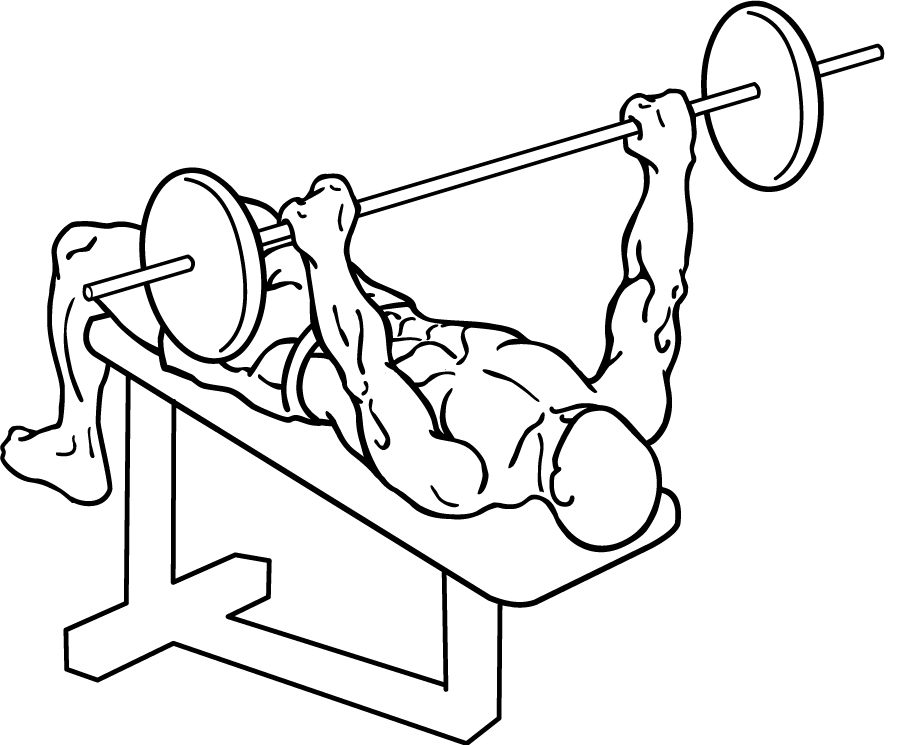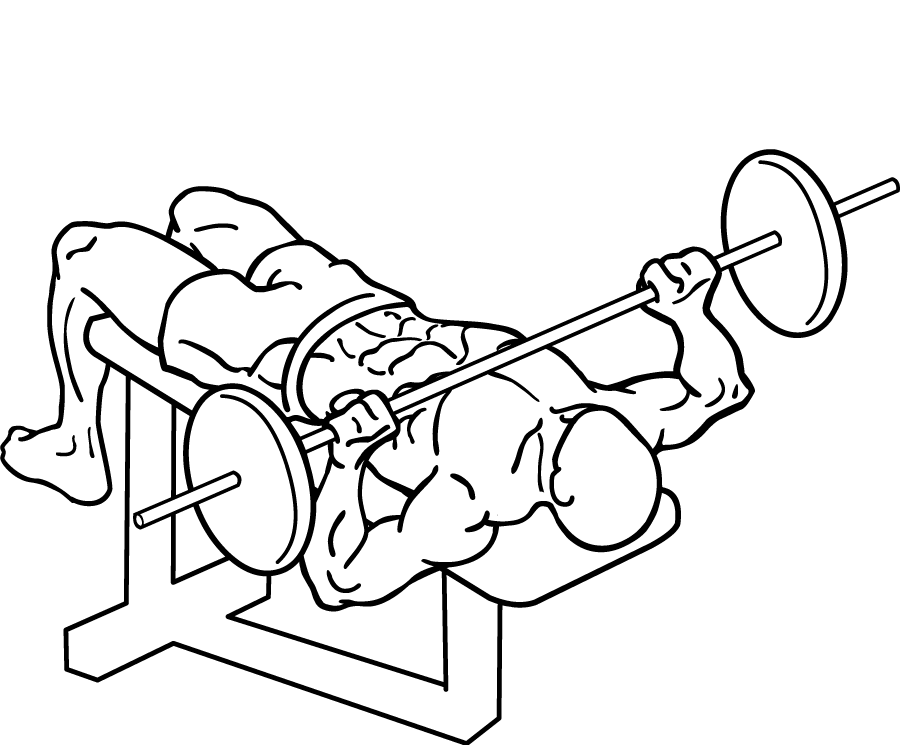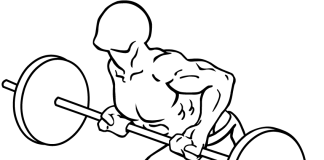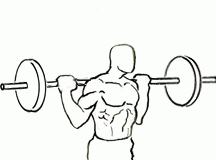Last Updated on October 3, 2023
The decline barbell bench press is an effective exercise for building upper body strength, with a particular emphasis on the chest, triceps, and shoulders. This variation of the traditional bench press is performed on a decline bench, which shifts the focus to the lower portion of the chest muscles while still engaging other key muscle groups. In this detailed guide, we will explore everything you need to know about the decline barbell bench press, including its benefits, how to perform it correctly, common mistakes to avoid, and how to integrate it into your workout routine.
What Is a Decline Barbell Bench Press?
The decline barbell bench press is a strength-training exercise performed on a bench set at a slight downward angle (decline). This angle places your head lower than your feet, which shifts the emphasis from the upper chest to the lower chest muscles. The movement involves pressing a barbell loaded with weight away from the chest and then lowering it back down in a controlled motion.
While the exercise primarily targets the chest muscles (pectoralis major), it also engages the triceps and the anterior deltoids (shoulders), making it a compound movement that enhances upper body strength and stability. It is a great addition to your workout routine, especially if you’re looking to diversify your chest training beyond the flat and incline bench press variations.
Muscles Worked During Decline Barbell Bench Press
- Lower Pectoralis Major (Chest): The decline angle of the bench emphasizes the lower portion of the chest muscles, helping to develop a fuller, more balanced chest.
- Triceps Brachii (Arms): The triceps are engaged throughout the pressing movement, contributing to elbow extension and supporting the chest muscles during the lift.
- Anterior Deltoids (Shoulders): The front part of your shoulders helps stabilize the weight and assists with the pressing motion, working in conjunction with the chest and triceps.
- Lats and Core: Though these muscles aren’t primary movers in the decline press, they play a supporting role in maintaining stability and control throughout the movement.
Benefits of the Decline Barbell Bench Press
Incorporating the decline barbell bench press into your workout routine offers several key benefits:
- Targeted Lower Chest Development: One of the primary reasons to perform the decline bench press is to target the lower part of your chest. By shifting the angle of the bench, you place more emphasis on this area, helping to create a well-rounded, fuller chest.
- Reduced Shoulder Strain: The decline angle places less stress on the shoulder joints compared to the flat or incline bench press, making it a great alternative for those who experience shoulder discomfort during traditional pressing exercises.
- Improved Triceps and Shoulder Strength: Since the triceps and shoulders are heavily involved in the pressing motion, this exercise helps strengthen these muscles as well, contributing to improved performance in other pushing movements and overall upper body strength.
- Variety in Your Workout Routine: Adding the decline barbell bench press to your routine helps to vary the stimulus on your muscles. This variation can lead to better muscle growth and strength development as it prevents your body from adapting to the same movements over time.
- Enhanced Muscle Balance: Focusing on the lower chest helps ensure that your chest muscles develop evenly, which can improve the overall aesthetics of your physique and prevent muscle imbalances.
Proper Technique for Decline Barbell Bench Press
To get the most out of the decline barbell bench press, proper form is crucial. Follow these steps to ensure you’re performing the exercise correctly:
- Set up the decline bench: Begin by adjusting the bench to a decline angle, typically between 15 to 30 degrees. Make sure the bench is stable and the barbell rack is positioned so you can comfortably unrack and rack the barbell.
- Lie down on the bench: Position yourself on the decline bench with your feet secured under the foot pads. Your head should be lower than your feet, and your back should be flat against the bench.
- Grip the bar: Grasp the barbell with an overhand grip, with your hands positioned about 3 to 6 inches wider than your shoulders. This wider grip allows for better engagement of the chest muscles. Your wrists should be straight, not bent, to prevent injury.
- Unrack the barbell: Carefully unrack the barbell and hold it directly above your chest with your arms fully extended. Keep your elbows slightly bent and your core engaged to maintain stability.
- Lower the barbell: Slowly lower the barbell in a controlled motion toward your lower chest. Keep your elbows close to your sides throughout the movement to maximize chest engagement and protect your shoulders from unnecessary strain.
- Pause at the bottom: When the barbell reaches your lower chest, pause for a brief moment. This pause increases muscle tension and ensures that you’re not bouncing the weight off your chest.
- Press the barbell back up: Push the barbell back up to the starting position by pressing through your chest and triceps. Focus on maintaining control throughout the movement, and avoid locking out your elbows at the top.
- Repeat: Perform the desired number of repetitions (typically 3 sets of 8-12 reps for muscle building) while maintaining proper form.
Common Mistakes to Avoid
To maximize the effectiveness of the decline barbell bench press and prevent injury, avoid these common mistakes:
- Flaring your elbows: Allowing your elbows to flare out during the press can place undue stress on your shoulders, increasing the risk of injury. Keep your elbows tucked close to your body to engage your chest and triceps more effectively.
- Using too much weight: Lifting too much weight can compromise your form and increase the risk of injury. Start with a weight you can control, and gradually increase the load as your strength improves.
- Bouncing the bar off your chest: Using momentum by bouncing the bar off your chest reduces the effectiveness of the exercise and increases the risk of injury. Lower the bar slowly and pause briefly at the bottom for maximum muscle engagement.
- Arching your back excessively: While a slight arch in the back is natural, excessive arching can strain your lower back. Keep your core engaged and maintain a neutral spine throughout the movement.
- Not using a spotter: For safety, especially when lifting heavy weights, it’s important to have a spotter present. A spotter can help you lift the weight safely if you fatigue during a set and ensure the bar doesn’t fall onto your chest.
Variations of Decline Barbell Bench Press
Once you’ve mastered the standard decline barbell bench press, consider incorporating these variations to further challenge your muscles and keep your workouts fresh:
- Decline Dumbbell Bench Press: Swap the barbell for dumbbells to engage stabilizer muscles and work each side of your body independently. This variation allows for a greater range of motion and can help correct muscle imbalances.
- Close-Grip Decline Bench Press: Bring your hands closer together on the bar to emphasize your triceps. This variation reduces the focus on the chest and increases the workload on your arms, making it a great triceps builder.
- Paused Decline Bench Press: Add a longer pause at the bottom of each rep to increase time under tension and challenge your chest and triceps more. This variation is great for improving strength and muscle control.
- Incline to Decline Superset: Perform a set of incline bench presses immediately followed by a set of decline bench presses. This superset targets all areas of the chest and ensures maximum muscle engagement.
- Tempo Decline Bench Press: Slow down the tempo of each rep by taking 3 to 4 seconds to lower the barbell and another 3 to 4 seconds to press it back up. This variation increases time under tension and promotes muscle growth.
How to Incorporate Decline Barbell Bench Press Into Your Workout Routine
To get the most out of the decline barbell bench press, it’s important to integrate it properly into your workout routine. Here are some tips on how to do that:
- Frequency: Aim to perform the decline bench press 1 to 2 times per week as part of your chest or upper body workout routine.
- Reps and sets: For muscle growth, aim for 3 to 4 sets of 8 to 12 repetitions. If your goal is strength, perform 4 to 5 sets of 4 to 6 repetitions with heavier weight.
- Combine with other chest exercises: Pair the decline barbell bench press with flat bench presses, incline presses, and chest flyes to target all areas of your chest for a well-rounded workout.
- Rest periods: Rest for 1 to 2 minutes between sets to allow your muscles to recover before the next set. This will help you maintain good form throughout your workout.
Is the Decline Barbell Bench Press Right for You?
The decline barbell bench press is a great exercise for those looking to develop a strong, balanced chest while also improving triceps and shoulder strength. However, it’s not for everyone. If you’re a beginner, you may want to start with flat or incline presses to build a foundation of strength before moving on to the decline version. Additionally, if you have shoulder or lower back issues, consult with a fitness professional to ensure the decline press is safe for you.
The decline barbell bench press is a powerful exercise that targets the lower chest, triceps, and shoulders, making it a valuable addition to any upper body workout routine. By following proper form, avoiding common mistakes, and incorporating variations, you can build a strong, balanced chest while enhancing your triceps and shoulder strength. Whether you’re an experienced lifter or someone looking to add variety to your chest workout, the decline barbell bench press offers unique benefits that can help you achieve your fitness goals.
To sum it up, mastering the decline barbell bench press takes time and practice. Be patient, focus on form, and gradually increase the weight as you get stronger. By incorporating it into your routine along with other chest exercises, you’ll be well on your way to a more powerful and defined upper body. Always listen to your body and, when in doubt, consult with a personal trainer or fitness expert to ensure you’re performing the exercise safely and effectively.
Final Tips for Success
- Warm Up Properly: Before performing the decline barbell bench press, it’s crucial to warm up your chest, shoulders, and triceps to prevent injury. Do some light cardio and dynamic stretches, followed by a few sets of light-weight bench presses.
- Stay Consistent: Like any exercise, consistency is key. Regularly incorporating the decline bench press into your routine will yield the best results over time.
- Progressive Overload: To continue seeing gains, apply the principle of progressive overload by gradually increasing the weight, reps, or sets over time.
- Mind-Muscle Connection: Focus on engaging the right muscles throughout the movement. By mentally connecting with the chest and triceps, you can ensure you’re getting the most out of every rep.
By following these tips and committing to a consistent training routine, you’ll see improvements in both your strength and the aesthetic development of your chest, triceps, and shoulders.








